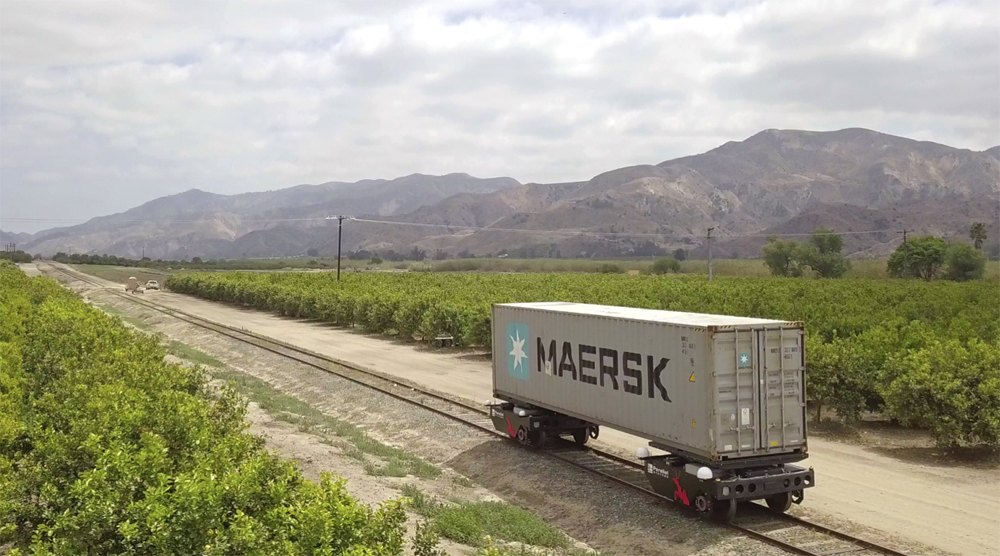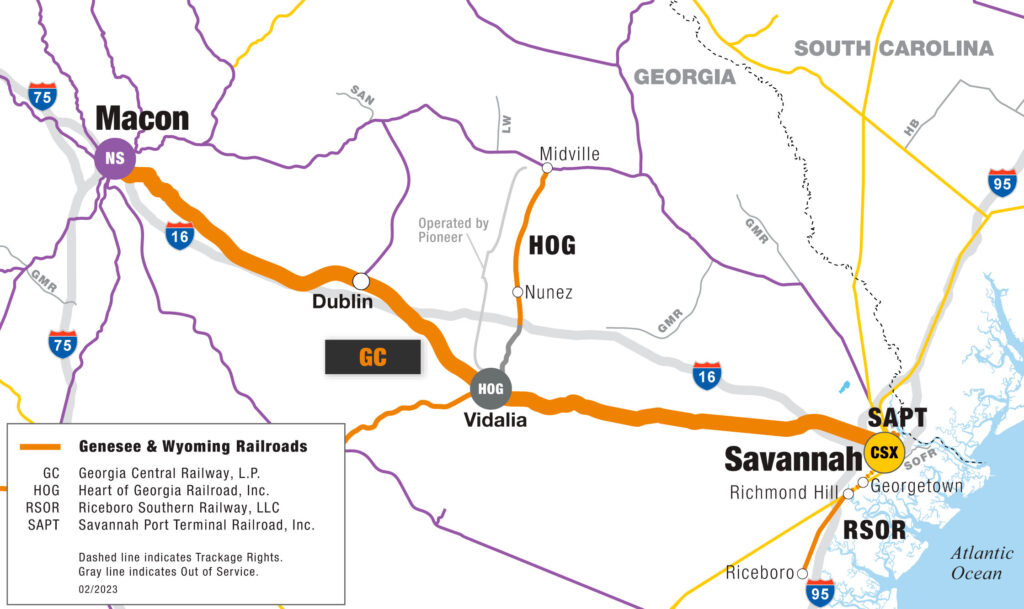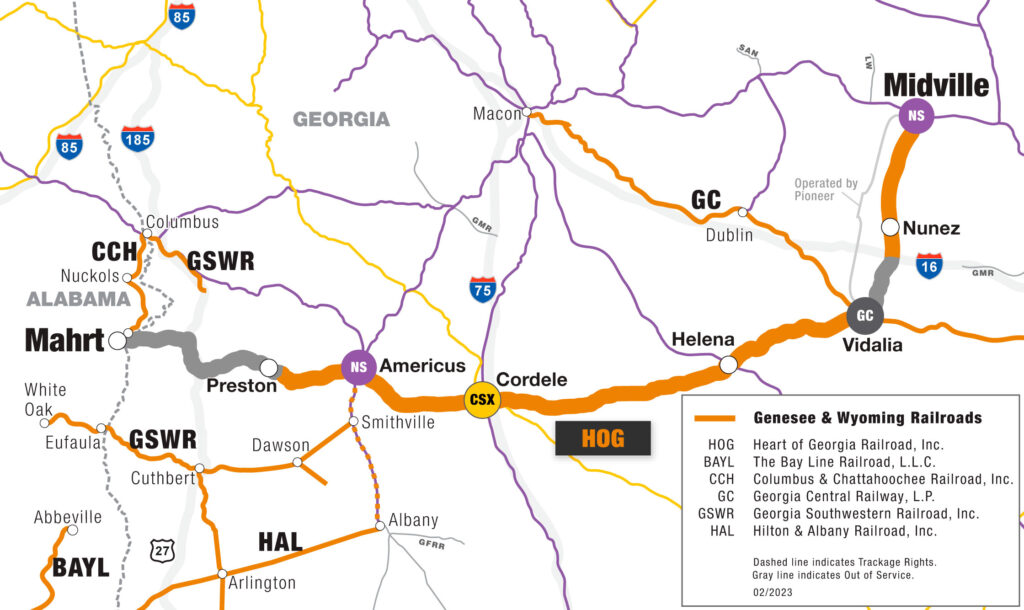
SAVANNAH, Ga. — Two Genesee & Wyoming short lines in Georgia today asked the Federal Railroad Administration to allow them to conduct a pilot program that would test Parallel Systems’ zero-emission autonomous container cars.
The 211-mile Georgia Central Railway and 233-mile Heart of Georgia Railroad would like to test the battery-electric cars – which can run alone or coupled together as an autonomous train – on portions of their lines beginning next year.
“GC and HOG believe the development and anticipated adoption of this technology has the potential to capture new container business moving to and from the Port of Savannah, as well as reinvigorate traffic on rural rail lines and revive inland ports in Georgia – all while removing trucks from the region’s roads and reducing carbon emissions,” G&W said.
The Port of Savannah is the fastest-growing containerport in the U.S.
If approved, the multi-phased pilot would be overseen by the FRA, G&W, and Parallel Systems, which G&W said would allow them to “demonstrate the technology in a field setting while using carefully developed protocols to ensure the pilot is operated in a safe, controlled manner.”
Parallel Systems, founded by a group of former SpaceX engineers in 2020, says its technology will allow railroads to expand their service alongside conventional operations while using existing infrastructure. The Los Angeles-based startup aims to help railroads capture freight off the highway and reduce the industry’s carbon footprint.
G&W’s waiver petition was not immediately available.
Parallel Systems’ video explains the concept behind the railcar and related intermodal system.
Georgia Central and Heart of Georgia connect in Vidalia, Ga.
















I’d like to know how reducing the carbon footprint is going to save the planet, meanwhile China and Russia are building, or have coal plants running, adding to the greenhouse emissions, these forced actions by the government is nothing but a way to tax and control, force people and business to do what government tells us, carbon emissions travel around the world, eventually arriving in the US polluting, A recent story about Biden wanting to build a giant filter over the US, another money grab, the US isn’t the only country, but the US is blamed for all the planet’s ills.
I can’t help thinking John G Kneiling would have loved this.
Yes, he would indeed love this idea.
I would imagine the rail unions might not be so impressed with this concept since, if it is ever fully developed, it could mean the end of a lot of operating (engineers/conductors) union-jobs.
I recall innovative John Knieling’s article from back in the 60s, for a coast-to-coast triple wide flat car, for enhanced quadrupled+ cargo container carrying capacity, that would span over an existing double track mainline that was properly parallel gauged. The ATSF interchanged (or merged) with the E-L RWY came to our minds, after reading that article. 🙂
This kind of technology may have a future in low-volumes, short-haul container moves within terminals or from docks to terminal, but running them on a mainline, with other rail traffic and grade crossings seems far-fetched. For now, at least.
If an hazardous material container derails in a city, who’s liable?
Paging John Nieling?
All new technology has naysayers & doomsday-for-labor & safety pundits. But if we didn’t innovate, we’d still be using steam engines and horses. I think this idea has strong merit, albeit w/ strong safety controls in place. If adopted, in the long run would it mean fewer rail jobs? Likely. But at least rail would still be competitive. Ask yourself, “How often do you use a long-distance operator, travel agents, bank tellers, or elevator operators?” I can see autonomous vehicles, properly configured, being much safer than today’s large HP locomotives pulling three-mile long trains. “Engineers” could be controlling numerous “trains” from a central location, with GPS, video, and a host of other connectivity. If the military can do it with drones in wartime, why can’t industry do it to be more efficient?
All of the limited capacity of a truck, with none of the annoying flexibility of the interstate highway system.
Bingo!
This is a rail intermodal marketing person’s dream. I hope it works.
Mr. Strawbridge: What’s your reply to Mr. Herbig’s post below?
The techies at Space X, just like all the other techies playing with generative AI are motivated by one thing; Move fast and break things and make buckets of $$$ putting lots of people out of work. Until one day their AI will come for their jobs too. Then it will be too late.
I just don’t see how this is better than short trains with COFC or spine cars. You still need cranes or sideloaders to load/unload the containers on each end, and now you’re servicing a lot more power units instead of just one or two. Plus, no couplers, so what happens if there’s a dud en route? You could push with one behind, I guess, but if there’s nothing behind then you’re stuck. An idea, but not one I would really recommend.
What could possibly go wrong?
SpaceX alumni and Tesla so-called Autopilot do not inspire confidence. A string of containers running through rural Georgia sounds like a very bad idea.
Maybe, but it is worth a try in small scale to see what the real problems are and if they can be fixed. I remember a lot of naysayers who said that stack trains would be top heavy and flopping all over the place. Now they are the standard and single car manifest trains are more the exception.
Not to diminish the levels of technology involved in this enterprise. But my key thought is safety, are these lines grade separated? If not what is the warning system besides the crossing signals in case of failure which needless to say does happen.
My 2nd thought is whether it will be cost effective to use such systems that tie up the line and restrict flexibility by not having crews on site to adapt to changing economic environments and work schedules.
I wondered about warning systems on the “train” no headlights, bells, or whistles. What would happen at an unguarded crossing as well as a crossing where the flashers go off… the vehicle after stopping looking and listening does not see or hear anything and proceeds assuming the flashers or gates have malfunctioned.
Steps whose positive effect will continue for a long time from two Genesee & Wyoming short lines in Georgia.
Dr. Güntürk Üstün